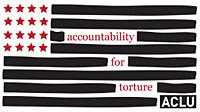The excerpt below from an excellent article by Alfred McCoy on the CIA at Abu Ghraib points, I believe, to the answer to a lot of questions. I'm thinking Guantanamo... Abu Ghraib... was the CIA standard operating procedure in these cases very different?
Few in the press have followed up on McCoy's excellent analysis. How well I understand that problem. Anyway, this is from his 2004 article, "The Hidden History of CIA Torture: America's Road to Abu Ghraib" (bold emphases added are mine):
With the controversy over Abu Ghraib, incidents that once seemed but fragments should now be coming together to form a mosaic of a clandestine agency manipulating its government and deceiving its citizens to probe the cruel underside of human consciousness, and then propagating its discoveries throughout the Third World.
Strong democracies have difficulty dealing with torture. In the months following the release of the Abu Ghraib photos, the United States moved quickly through the same stages (as defined by author John Conroy) that the United Kingdom experienced after revelations of British army torture in Northern Ireland in the early 1970s -- first, minimizing the torture with euphemisms such as "interrogation in depth"; next, justifying it on grounds that it was necessary or effective; and finally, attempting to bury the issue by blaming "a few bad apples."
Indeed, since last April, the Bush administration and much of the media have studiously avoided the word "torture" and instead blamed our own bad apples, those seven Military Police....
In August [2004], Major General George R. Fay released his report on the role of Military Intelligence at Abu Ghraib. Its stunning revelations about the reasons for this torture were, however, obscured in opaque military prose. After interviewing 170 personnel and reviewing 9,000 documents, the general intimated that this abuse was the product of an interrogation policy shaped, in both design and application, by the CIA.
Significantly, General Fay blamed not the "seven bad apples," but the Abu Ghraib interrogation procedures themselves. Of the 44 verifiable incidents of abuse, one-third occurred during actual interrogation. Moreover, these "routine" interrogation procedures "contributed to an escalating 'de-humanization' of the detainees and set the stage for additional and severe abuses to occur."
After finding standard Army interrogation doctrine sound, General Fay was forced to confront a single, central, uncomfortable question: what was the source of the aberrant, "non-doctrinal" practices that led to torture during interrogation at Abu Ghraib? Scattered throughout his report are the dots, politely unconnected, that lead from the White House to the Iraqi prison cell block: President Bush gave his defense secretary broad powers over prisoners in November 2001; Secretary Rumsfeld authorized harsh "Counter-Resistance Techniques" for Afghanistan and Guantanamo in December 2002; hardened Military Intelligence units brought these methods to Iraq in July 2003; and General Ricardo Sanchez in Baghdad authorized these extreme measures for Abu Ghraib in September 2003.
In its short answer to this uncomfortable question, General Fay's report, when read closely, traced the source of these harsh "non-doctrinal methods" at Abu Ghraib to the CIA. He charged that a flouting of military procedures by CIA interrogators "eroded the necessity in the minds of soldiers and civilians for them to follow Army rules." Specifically, the Army "allowed CIA to house 'Ghost Detainees' who were unidentified and unaccounted for in Abu Ghraib," thus encouraging violations of "reporting requirements under the Geneva Conventions." Moreover, the interrogation of CIA detainees "occurred under different practices and procedures which were absent any DoD visibility, control, or oversight and created a perception that OGA [CIA] techniques and practices were suitable and authorized for DoD operations." With their exemption from military regulations, CIA interrogators moved about Abu Ghraib with a corrupting "mystique" and extreme methods that "fascinated" some Army interrogators. In sum, General Fay seems to say that the CIA has compromised the integrity and effectiveness of the U.S. military.









No comments:
Post a Comment